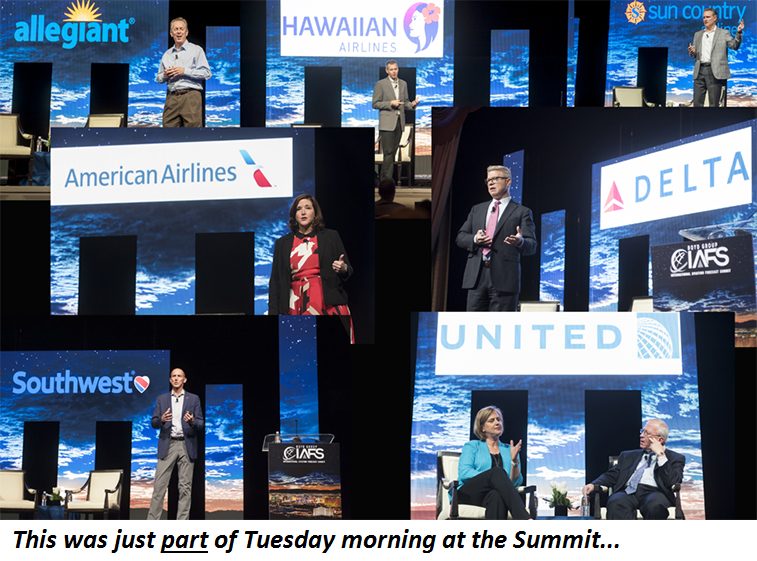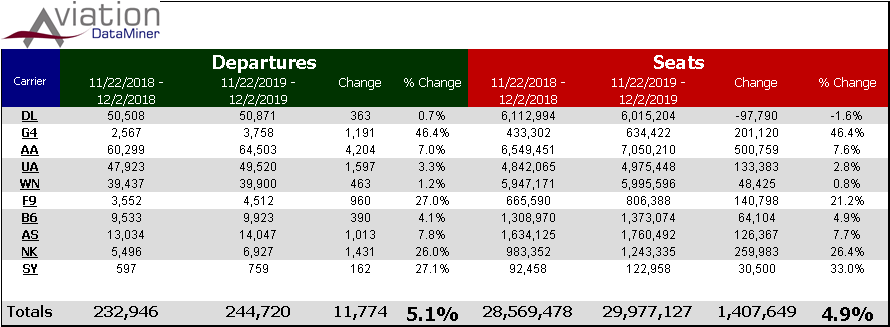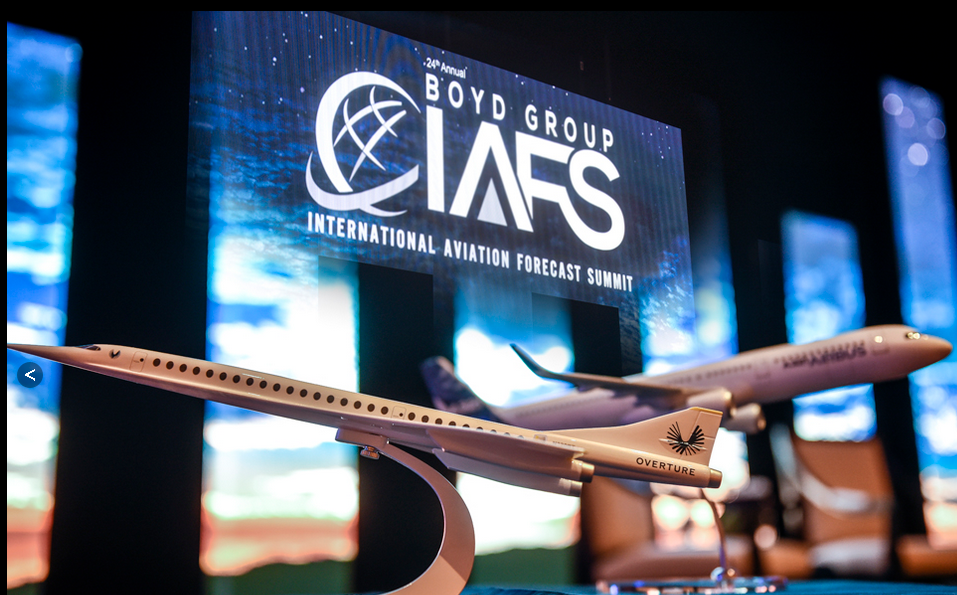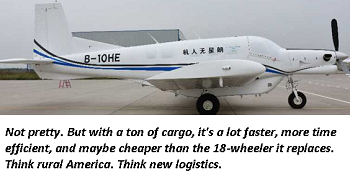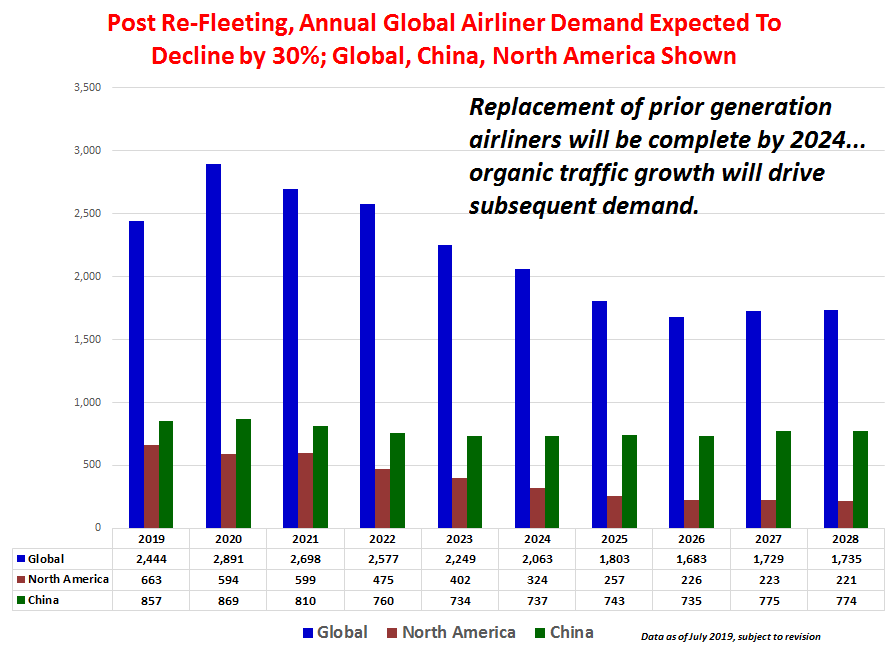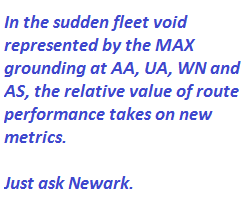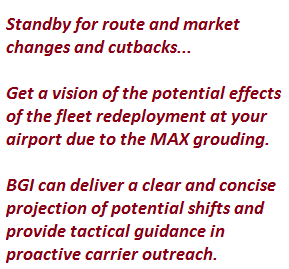Disruptive Opportunities In Aviation’s Future
If you’re joining aviation leaders at the International Aviation Forecast Summit, August 25-27, come prepared for some serious heresy…
The global and industry media will be there, too, so it’s all on the record.
Global Manufacturing & Logistics – New Metrics for US Aviation. Traditional channels of global trade are changing.Fundamentally – in a decade they will barely resemble what we see today.
Hint: the value of time will increasingly be the new metric – replacing labor cost – which is starting to get zapped off the advantage list with expanding robotic manufacturing.
The latent advantages  of the US aviation system as a distribution and communication system has been missed entirely. The assumption is that sweatshops in backward nations have an unshakable lock on manufacturing. Think again. And new aviation channels will be a foundational part of it.
of the US aviation system as a distribution and communication system has been missed entirely. The assumption is that sweatshops in backward nations have an unshakable lock on manufacturing. Think again. And new aviation channels will be a foundational part of it.
Traffic Growth Profiles Have Shifted: U.S. air traffic, coming off of a 5.5% expansion in 2018, is tracking close to 4% this year, and indications for nearly 3% annually in the next decade. One reason: it’s no longer just “air service.” Airlines are increasing posturing air travel as a discretionary spend. That tosses traditional forecast methodologies into the land fill.
The Fleet Pain Is Over. Most of the downsides attendant to airline fleet shifts – such as the continuing reduction on 50-seat fleets – have already been registered. The small airport air service issue has been decided already.
New Facilities at Istanbul, Shanghai and Beijing. But We Already Have An Airport at Worland, Wyoming – and over 3,500 more. Don’t laugh. It’s a pertinent point. Reality: the U.S. is today prepared for the new global manufacturing, trade and logistics systems that will emerge in the next decade. We’re covering it at the IAFS.
New Powerplant Technology – Can Electric Make A Difference? Maybe sooner than we think. Extension cords not required.
New Business Intelligence Channels – New Metrics Needed. The new aviation industry needs new metrics… because it’s a new set of businesses.
And these just cover a couple of the highlights of the IAFS…
Mind-Challenging Concepts and Perspectives That Go Beyond Droning Panels
The Boyd Group International Aviation Forecast Summit is just a bit more than a week away. It promises to be the most exciting, innovative, and thought-disruptive in our 24 years of the event.
 First, we want to thank all of our sponsors of this year’s IAFS™ including our Platinum Sponsors, Southwest Airlines and United Airlines.
First, we want to thank all of our sponsors of this year’s IAFS™ including our Platinum Sponsors, Southwest Airlines and United Airlines.
We want to acknowledge the teams that are participating in the pre-Summit Workshop program on Sunday afternoon. These offer more insight than other conferences in their entirely.
All are exciting, and the Cirium Workshop – What A Difference A Data Makes – will set whole new perspectives in aviation data and planning.
IAFS™ – The Only Event Entirely Focused On The Future
The entire IAFS™ is engineered to illuminate the futurist views of the thought-leaders shaping aviation. It’s all about exploration, based on their views – not pre-canned subject panels that are cookie-cutter sessions at other conferences.
In addition to the incisive views from aviation leaders, there’s a range of forecasts that no other event even gets close to.
Let’s touch on them…
Traffic & Trend Forecasts – We Have The Future Surrounded
First, Airports:USA™ – these are the only airport forecasts accomplished entirely independently in the private sector. No political interference, and no second-agendas. Most importantly, Airports:USA™ is based on real-world traffic factors, not the methodologies used by the FAA, which were largely founded on the airline industry that existed back when Dwight and Mamie were ensconced at 1600 Pennsylvania. They don’t work today.
We’ll be covering the new drivers of passenger growth – how econometrics alone are not reliable, and how aviation planners can look to the new factors that generate air traffic.
Expect a couple of sacred cows to get barbecued – we’re going to illuminate how a number of traditional traffic-enhancement assumptions – a.k.a. some “air service development” approaches – are now like attempting to get a cadaver ready for a ballroom dance competition.
Key Factor: We’ll be outlining where spikes in growth will take place due to changing global logistics channels, and how the U.S. airport system puts the USA in the crosshairs to benefit. Big time.
New Airport Planning. Contrarian – But Accurate – Thinking. Yes, there are great airports built elsewhere in the world, like the new Istanbul facility, Singapore Changi, Shanghai Pudong’s new 83-gate addition, and the soon to be opened Beijing Daxing International. Big money being invested now – elsewhere in the world. Don’t hear much about what’s going on here… because it’s already happened.
“Other countries are investing in the future, and we’re not!” the pundits announce, typically with the cliché comparison to the old LGA terminal. A wonderful terrarium of closed thinking. Nothing like the safety of group-think.
Here’s a rap-stopper for their next cocktail party. The USA has indeed invested billions in a robust airport system. It’s in place and ready for the new emerging global business environment.
Yup. Airports like Worland, Lynchburg, Merced, Pittsfield, Gaylord, Thief River and Glendive, and 3,500 more such facilities – whether commercially-served or not – are our future global advantage, particularly in light of major, structural and fundamental changes in global manufacturing, trade and logistics, which, again, we’ll discuss at the IAFS.
We’ll be outlining the how’s and whys. One idea: don’t miss the pre-Summit Workshop on the future of drones – they are a key part of the new future.
Yes, this would appear to be lunacy… and it certainly can be called that, within the context of today.
But the Summit is all about the future.
Get your heresy freak on, and join us at the Airports:USA® session.
A4A & IATA At The Summit. And, not to worry, there will be lots of additional forecast perspectives at the IAFS™.
We are honored to have John Heimlich, Chief Economist of Airlines 4 America, with his ten-year forecast. For the international perspective, IATA will have Andrew Matters, Deputy Chief Economist at the Summit.
Then toss in our exclusive Airports:China™ projection of that nation’s traffic at its 200 largest airports, including potential new U.S. gateways to China, and we’re coming at global and domestic forecasts from all sides.
Airline Fleets – Planning For New Air Travel Dimensions
Aviation and global logistics will be affected by the fleets that will be coming into operation in the future.
As usual, we have our friends from Airbus, Boeing, Embraer, Boom Supersonic and Rolls-Royce presenting their individual perspectives of the future fleets and operating systems we’ll be seeing in the next ten years.
But this year, we’re excited to have two more dimensions added.
Electric... On the smaller end – Bye Aerospace will present the future and the opportunities of electric aircraft. Battery technology is making huge strides.
Hypersonic – On the more futurist end – Hermeus Hypersonic will be at the Summit to outline the potential for travel at 5X the speed of sound. For military applications, this concept barely gets any notice. But for passenger air travel, well, people just roll their eyes. AJ Piplica, founder of Hermeus,will probably have some visions that no other aviation event can get close to.
Fuel Forecast – It’s More Than Just Supply & Demand
This year again we welcome Mr. Ben Brockwell, Director of Oil Price Information Services, to discuss the dynamics that will determine what airlines will be paying for fuel. It’s more than just the price of the stuff coming out of the ground… it has to do with other demands on middle distillates, the current and expected shifts in regional usage, changes in refinery capacity, and a lot more.
Networking? Bring Lots of Business Cards
Aviation leaders from across the industry and the world will be at the Summit. It’s the people that will be making the future happening.
Plus, in addition to the CEOs and senior executives from carriers across the globe, there will be over 60 attendees from airlines such as Southwest, American, Delta, Spirit, and many more. So, get ready to network at breaks and the exiting receptions on Sunday and Monday evenings.
Finally, The Fourth Estate, Covering The IAFS
The IAFS is a globally-respected aviation forecast event.
So, it’s actively covered by global media, including outlets such as the Wall Street Journal, Reuters, Bloomberg, CNBC, CBS, and professionals in print and electronic channels across the aviation spectrum. This year, Peter Greenburg will be holding his Worldwide CBS travel show, with recorded broadcasts from the IAFS.
Lots More, Too
If you haven’t registered, click here and plan on being at the Wynn/Encore August 25-27.
We look forward to seeing you and discussing the future!
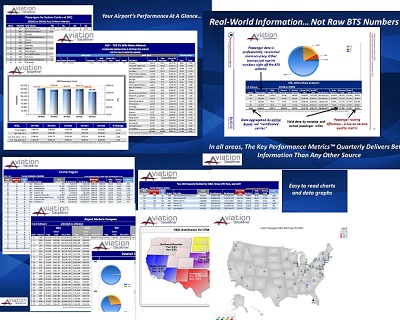
 by the BGI Key Performance Metrics report. The period is full year ending 2Q 2015.
by the BGI Key Performance Metrics report. The period is full year ending 2Q 2015.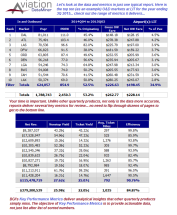
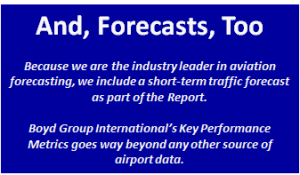 We’ve done a short tour of Key Performance Metrics. Just
We’ve done a short tour of Key Performance Metrics. Just 